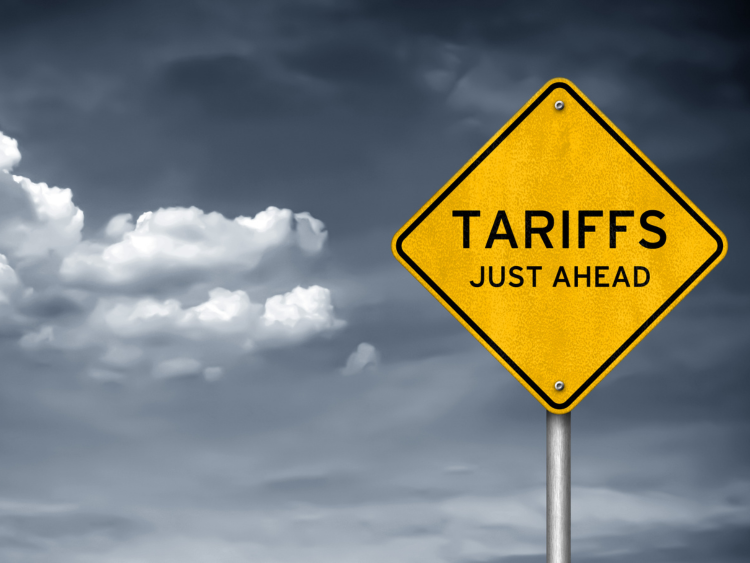Trade Cases

Strong Reactions to Trump’s 232 Tariff
Written by Tim Triplett
March 1, 2018
President Trump’s announcement today of his intention to impose a 25 percent tariff on steel imports puts the steel industry on course for historic change. Historically good or historically bad, or perhaps some of both, depends on the individual’s perspective. Following are some of the reactions Steel Market Update received from readers, whose names were withheld so they could speak frankly:
- “March Madness is here. Get ready for an interesting 3-6 months. Strong demand combined with decreased supply may drive HR to $900 by mid-Q2.”
- “Steel prices might increase once the announcement is formally made. However, the impact on the cost of goods increasing is largely blown up by the fake news media. The increased cost of an automobile might go up $35. The cost of a building will increase without a doubt, but with tax cuts and regulations removed the tradeoff and benefits will negate any additional cost on building. Fair trade and American jobs protection have been ignored far too long and now we have leadership who wants to turn that around. The stock market is overreacting to this tariff announcement that is still pending until next week. Supply of steel in the short term could get tighter. I heard that Nucor and SSAB are talking allocations and controlled order entry. 2018 is lining up to be historic in the metals industry. This is just getting started”
- “It will raise steel prices, although I am not sure how much. We are already at a disadvantage to much of the world on steel prices as it is. It will probably push out lead times as companies that were importing scramble to secure domestic supply. The one bright spot is that the president mentioned no quotas. We can get steel, even though it may cost more, so there should not be any long-term shortages. Absent any other trade action, this definitely will put U.S. manufacturers at a disadvantage to foreign competition.”
- “Economics 101 says import prices will go up 25 percent as will the domestics. In fact, the domestics have been heading that way for some weeks now. There have been some significant cancellations by several import traders since the DOC recommendations came out, which will make for a gap in the regular supply in two months or so. The domestics are already talking in terms of ‘controlled booking.’ Mid-term, however, the supply will equalize, just at a higher price. Therein lies the rub. The downstream manufacturers and consumers will be the real losers.”
- “The big question is whether it is universally applied across all countries or it ends up targeting the 12 countries that have been identified as ‘bad actors.’ I do not think the president will risk a trade war, especially with important trading partners. If the tariffs are implemented across the board, we can easily be looking at 2008-type prices. The number $1,075 was the per-ton CRU peak in 2008. I adamantly believe the impact will be on service centers and OEMs who have been heavily dependent on off-shore. The mills I am working with are not doing their ‘new best friends’ any favors on spot pricing or availability, nor should they. I am not worried about our supply from the domestics.”
- “This sounds very scary to me. I hope it will be used to negotiate trade agreements and exceptions. Pricing is no longer based on supply and demand. Our export business will probably get cut in half or more due to other countries retaliating. We will try to pass on increases to customers, but we are already behind the curve.”
- “Hyperinflationary all the way around, 2008 all over again. Commerce is stacked with steel people.”
- “My sense of the market’s response was that if Trump rejected the DOC recommendation, the market would fall $5/cwt over course of few months. If he imposed a 24 percent tariff, prices would rise $10/cwt. If a 53 percent tariff, prices would rise $15/cwt. I’ll stick to my hunch and say that domestic base prices will rise to the mid to high $50s. That would be an equivalent to about 17 percent on a delivered basis, which passes the sniff test of a 25% tariff.”
- “It is obviously going to be supportive of higher prices, although I think additional upward movement may be more limited than people think. Prices are already pretty high, and mill margins healthy. I’ll be interested to see if the mill’s take a longer-term view and employ a less opportunistic strategy, considering they are in a profitable position to start. From a supply standpoint it provides clarity and will likely give importers the ability to begin offering again assuming they have the production cost position to absorb the new duty. Some are already indicating they will do just that. It’s unclear how much import will realistically be able to come here, but any increase in import activity may help slow down additional domestic increases. The impact on end-users really depends on the steel intensity of the products they produce and their specific competitive landscape. It’s definitely something to be concerned about longer-term.”
- “In the short run, steel prices are going to go up. I’m making sure that my steel suppliers are keeping me in supply as I suspect many of the foreign steel buyers will likely need to purchase material domestically. It is wishful thinking to assume that other countries will not retaliate. There was plenty of anxiety in the marketplace waiting to see the outcome of Section 232. Now that we know, the anxiety is going to shift to what those ramifications are going to be. Long-term, I think this will only hurt our economy. Will President Trump’s decision include Canada and Mexico or will they be excluded due to NAFTA?
- “The devil is in the details. Are semis included, is Canada part of this and will steel from Canada get the 25 percent tariff? If slabs are included, our primary source of galvanized steel (CSI) will be negatively impacted. If Canada is included, our primary source for HRPO (Algoma) will be impacted. I can’t begin to imagine the scenarios at other manufacturers. Mills are already late and lead times are going out. This is going to result in allocations, shortages and much higher prices.”
- “Price will continue to escalate with no end in sight. We could move to a market of price in effect at time of shipment and customers asking for steel with no concern of the price, just get us the steel.”
- “Domestic mills are already ‘closing’ books, in some cases through May. I don’t know for sure that they are closed because they have sold all their capacity or because they were waiting to see how much they can now charge. It is a fact that domestic mills cannot supply all the demand. So, some of us will have no choice but to pay the tariff to ensure supply. Are mills in NAFTA countries considered foreign steel? Since we have already lost some of our business to foreign producers, I see this pushing more and more of our customers to purchase overseas for more competitive prices. Also, what a boon for Mexican manufacturing! The effect on end-user manufacturers is apparently not a consideration of the White House.
- “This could drive prices up above $1,000/ton HR, but for how long? At these prices, people will find new supply, both import and ‘new’ domestic sources that will eventually bring prices back down. The big concern I have is that a 25 percent tariff is bigger than is necessary. Does this drive manufacturing offshore long term? It seems we could have gotten ‘enough’ protection for the mills with a number half that size. This will cause a large issue for all the credit managers in our industry for the balance of the year. Will the credit risk and constraints be the issue that chokes off this market? Get ready for a fun ride.”
- “Customers will for sure accept the 25 percent increases since they need the steel and we are coming into the busier times for demand. This will separate the import pack a bit. In my area of coated, the countries with AD/CVD duties will have a disadvantage i.e. Taiwan 10 percent plus 25 percent= 35 percent. For many customers that need thinner material, import will still be major player. The domestics are going to lower the boom on spot. They are already at 75-76 percent production levels, so they will be at 80 percent plus soon. Scrap could go up $50-80 per ton soon, so the U.S. mills will be forced to keep the pedal down on price increases. The world market is on fire for HR coil, it is not just the U.S., so we are in for a tighter and higher market.”
- “President Trump is a baboon, and worse than that he’s an ignorant baboon. Ignorance and power are a terrible combination. He let slip his plan for this tariff with no specificity of what country or what product it may impact. If he will be so broad and blunt as to make it apply to every country and every product, then in my opinion it will be a disaster for the manufacturing sector in the United States. Are there countries engaging in unfair trade practices and are there certain products that are damaging U.S. producers of those same products where there is justification for some protection? Sure. But there are also many products that aren’t being harmed by foreign competition and there are many products that are in short supply here in the U.S. To add 25 percent to all imported steel would be to give huge profits to all the steelmakers at the expense of everyone else in the supply chain. It will dramatically incent overseas manufacturers of steel-containing components to make and ship more of those components here without any tariffs. It will dramatically erode the ability of the manufacturers of those components based in the United States to survive, much less prosper. Short-sighted steel producers may will applaud his decision now, but in five or 10 years they will sincerely regret it when they look out their windows and see far fewer customers. This is a very sad day for a once great country and not at all the way to make this country great again.”
- “I hope we have some customers left in this country in 12-24 months. Meanwhile, now is the time when strong relationships with both your suppliers and your customers are critical. It’s going to be tougher to get steel over the next few months for many reasons, and suppliers are going to take care of customers that value the partnership.”

Tim Triplett
Read more from Tim TriplettLatest in Trade Cases

Industry piles on new Section 232 steel derivative inclusion requests
The Department of Commerce received 97 submissions from producers, manufacturers, and groups seeking Section 232 tariff coverage for steel and aluminum derivative products.

Price on Trade: New EU steel tariffs don’t mean the US should weaken its stance
Any steel imports into the EU that exceed the new, lower quota level would be subject to a 50% tariff, which represents a major increase from the EU’s current 25% out-of-quota tariff. This move would largely align the EU’s steel tariff rate with Canada and the United States.

Global steel forum sets 2026 framework deadline as US ups pressure on excess capacity
Global steelmakers sounded the alarm Friday over the deepening excess steelmaking capacity crisis. Ministers at the Global Forum on Steel Excess Capacity (GFSEC) in Gqeberha, South Africa, pledged to...

CRU: China’s indirect steel exports find new destination markets
The boom in China’s direct steel exports has not stopped this year, even with a rise in protectionist measures globally. The increase is driven by...

U.S. Steel sues Algoma over iron pellet shipments
U.S. Steel is suing Algoma over the Canadian flat-rolled producer's rejection of iron pellet shipments, arguing it has breached its contract.
